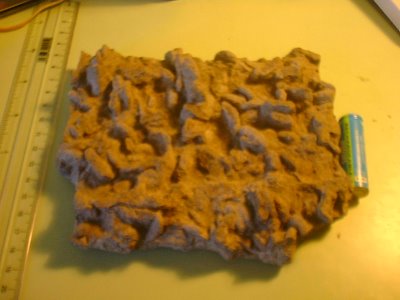 Click for full-size image?
Click for full-size image?Just been digging around in the rock pile, and I found this rock which I'd recently described in a USENET post:
The cohesiveness of consolidated mud would
provide a comparatively resistant surface over
which coarser-grained sediments could be
transported as a package.
Actually, thinking about it, I've a nice specimen
in my rock pile showing a similar event from
100-odd million years ago. Mid-jurassic of the
Isle of Wight, there was a muddy sea-bottom
with a rich fauna of burrowing worms chomping
away buried in their nice muddy burrows. Then
along came a flood of silty sand which buried
and killed off the worms leaving a series of
sandy casts of the top ends of the burrows on
the *under* surface of a circa-2cm thick sand
bed.
One hundred million years later along comes a
superannuated hippie of a geology student who
extracts said thin sand bed from a 10-odd metre
high cliff of similarly interbedded muds and
sands, and carefully appreciates the day in
the death of these worms before spending
hours in the pub (and back in the honours
year student labs) carefully picking out the
bits of clay from between the casts of the
burrows.
"AA" size cell and a ruler to give scale objects. The autofocus of the camera seems to be slipping, and there's no manual alternative. I'm thinking that I can almost justify getting a new camera.
2005-11-29
Carsten described these as "escape structures". I don't think so - I think they're burrows which the worms (lugworm or equivalent) died in after getting a belly full of sand. The underlying mudstone bed contains sub-vertically oriented sand tubes dispersed through the mud, representing the worms which swallowed a sand meal, stopped eating, swallowed (separating the swallowed sand from the continuous sheet), then died.
Please note that this photograph is of the UNDERSIDE of the slab as originally found, in a normally oriented sediment sequence.
